Comprehensive Report: Performance Management at Qantas
VerifiedAdded on 2022/08/13
|11
|2591
|18
Report
AI Summary
This report provides a comprehensive analysis of the performance management system at Qantas, an Australian airline. It begins by examining the company's shift to cloud-based HR systems, specifically Workday, and the approach of the organization. The report then delves into interviews with HR managers to understand the processes, policies, strengths, and weaknesses of the system. It explores stakeholder perspectives, including HR managers, suppliers, and employees, to identify issues and challenges associated with managing electronic performance systems. The report also addresses the management of disabled persons within the performance management process, highlighting diversity considerations. Finally, it outlines how performance appraisals are converted into training and development plans for employees, including the use of performance appraisal software. The report integrates various sources and provides a detailed overview of the Qantas's performance management practices.
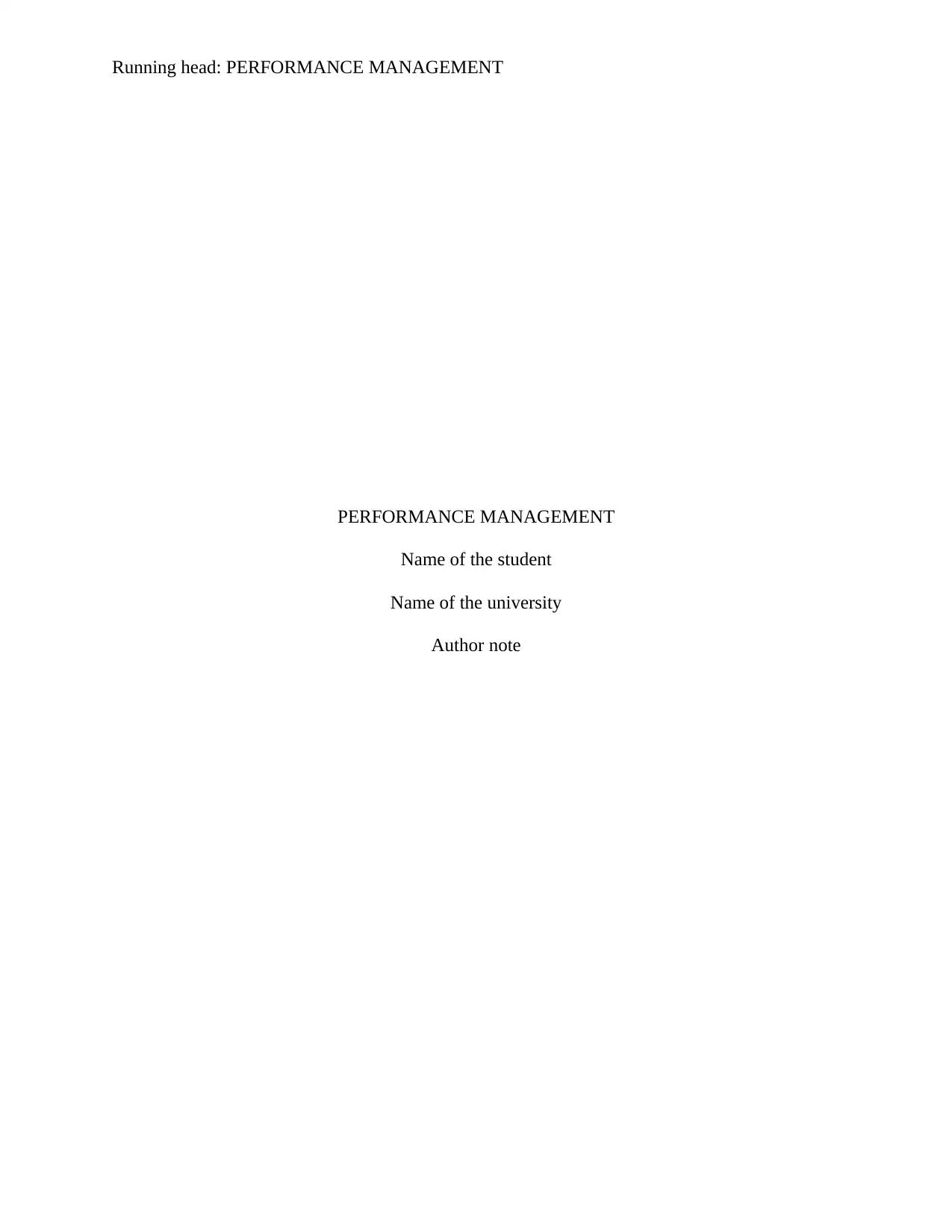
Running head: PERFORMANCE MANAGEMENT
PERFORMANCE MANAGEMENT
Name of the student
Name of the university
Author note
PERFORMANCE MANAGEMENT
Name of the student
Name of the university
Author note
Paraphrase This Document
Need a fresh take? Get an instant paraphrase of this document with our AI Paraphraser
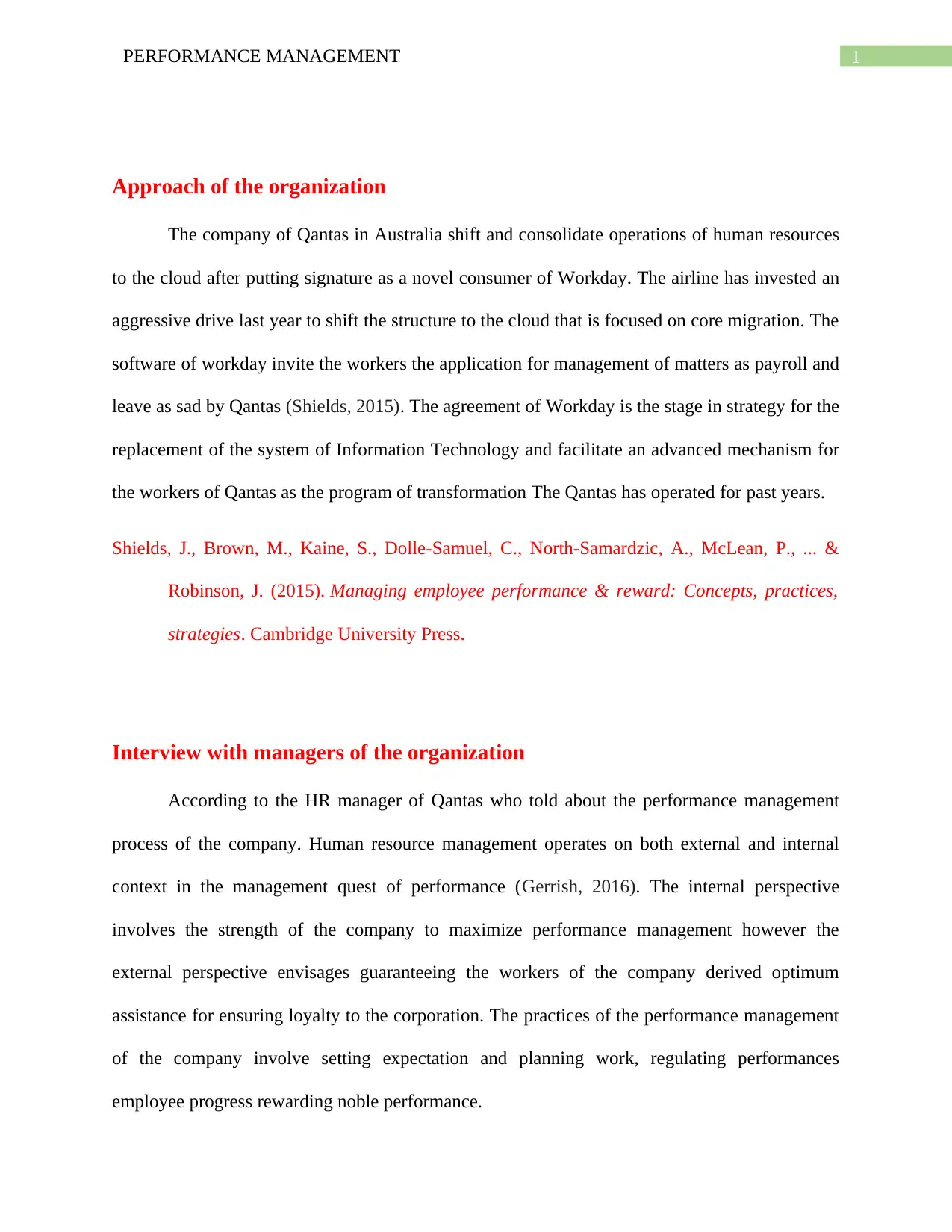
1PERFORMANCE MANAGEMENT
Approach of the organization
The company of Qantas in Australia shift and consolidate operations of human resources
to the cloud after putting signature as a novel consumer of Workday. The airline has invested an
aggressive drive last year to shift the structure to the cloud that is focused on core migration. The
software of workday invite the workers the application for management of matters as payroll and
leave as sad by Qantas (Shields, 2015). The agreement of Workday is the stage in strategy for the
replacement of the system of Information Technology and facilitate an advanced mechanism for
the workers of Qantas as the program of transformation The Qantas has operated for past years.
Shields, J., Brown, M., Kaine, S., Dolle-Samuel, C., North-Samardzic, A., McLean, P., ... &
Robinson, J. (2015). Managing employee performance & reward: Concepts, practices,
strategies. Cambridge University Press.
Interview with managers of the organization
According to the HR manager of Qantas who told about the performance management
process of the company. Human resource management operates on both external and internal
context in the management quest of performance (Gerrish, 2016). The internal perspective
involves the strength of the company to maximize performance management however the
external perspective envisages guaranteeing the workers of the company derived optimum
assistance for ensuring loyalty to the corporation. The practices of the performance management
of the company involve setting expectation and planning work, regulating performances
employee progress rewarding noble performance.
Approach of the organization
The company of Qantas in Australia shift and consolidate operations of human resources
to the cloud after putting signature as a novel consumer of Workday. The airline has invested an
aggressive drive last year to shift the structure to the cloud that is focused on core migration. The
software of workday invite the workers the application for management of matters as payroll and
leave as sad by Qantas (Shields, 2015). The agreement of Workday is the stage in strategy for the
replacement of the system of Information Technology and facilitate an advanced mechanism for
the workers of Qantas as the program of transformation The Qantas has operated for past years.
Shields, J., Brown, M., Kaine, S., Dolle-Samuel, C., North-Samardzic, A., McLean, P., ... &
Robinson, J. (2015). Managing employee performance & reward: Concepts, practices,
strategies. Cambridge University Press.
Interview with managers of the organization
According to the HR manager of Qantas who told about the performance management
process of the company. Human resource management operates on both external and internal
context in the management quest of performance (Gerrish, 2016). The internal perspective
involves the strength of the company to maximize performance management however the
external perspective envisages guaranteeing the workers of the company derived optimum
assistance for ensuring loyalty to the corporation. The practices of the performance management
of the company involve setting expectation and planning work, regulating performances
employee progress rewarding noble performance.
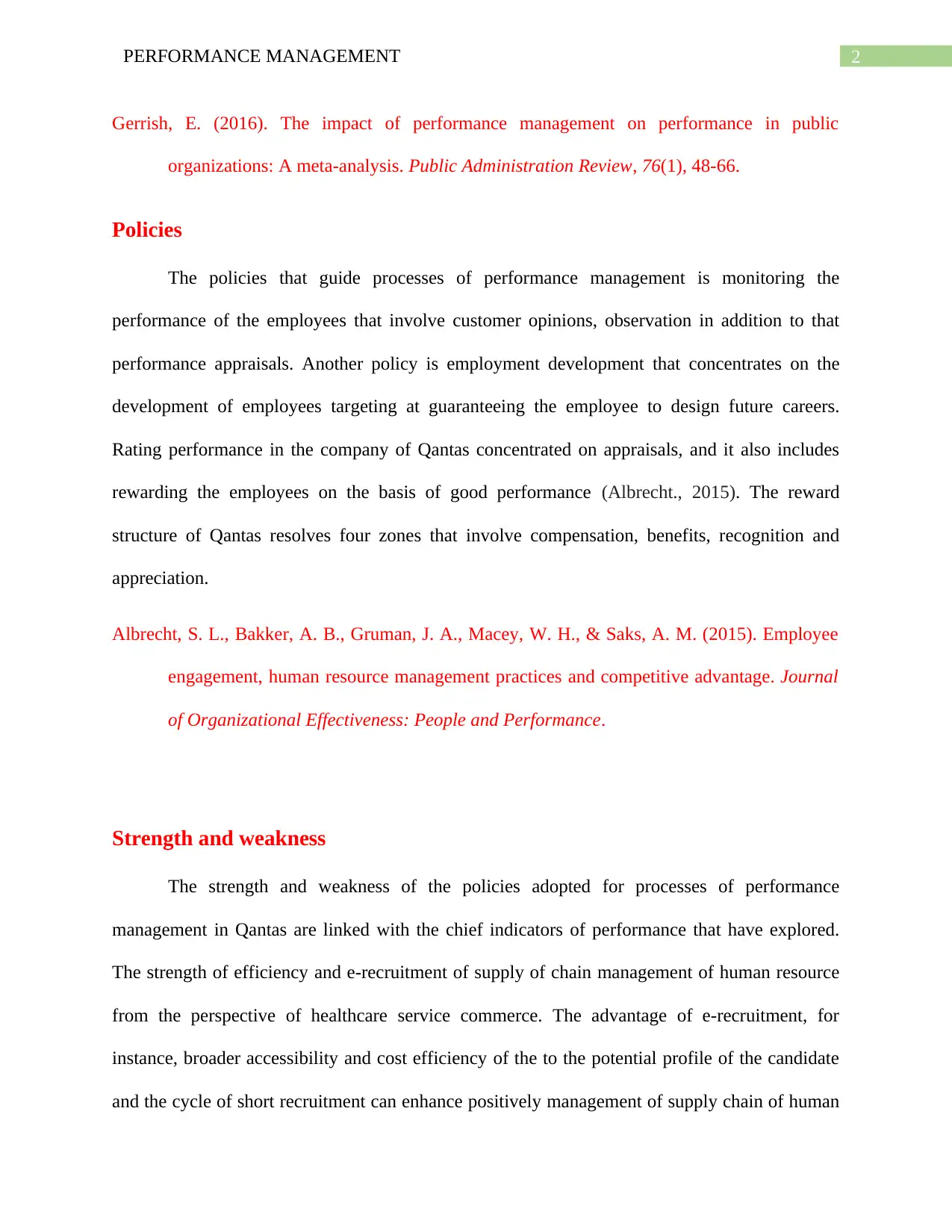
2PERFORMANCE MANAGEMENT
Gerrish, E. (2016). The impact of performance management on performance in public
organizations: A meta‐analysis. Public Administration Review, 76(1), 48-66.
Policies
The policies that guide processes of performance management is monitoring the
performance of the employees that involve customer opinions, observation in addition to that
performance appraisals. Another policy is employment development that concentrates on the
development of employees targeting at guaranteeing the employee to design future careers.
Rating performance in the company of Qantas concentrated on appraisals, and it also includes
rewarding the employees on the basis of good performance (Albrecht., 2015). The reward
structure of Qantas resolves four zones that involve compensation, benefits, recognition and
appreciation.
Albrecht, S. L., Bakker, A. B., Gruman, J. A., Macey, W. H., & Saks, A. M. (2015). Employee
engagement, human resource management practices and competitive advantage. Journal
of Organizational Effectiveness: People and Performance.
Strength and weakness
The strength and weakness of the policies adopted for processes of performance
management in Qantas are linked with the chief indicators of performance that have explored.
The strength of efficiency and e-recruitment of supply of chain management of human resource
from the perspective of healthcare service commerce. The advantage of e-recruitment, for
instance, broader accessibility and cost efficiency of the to the potential profile of the candidate
and the cycle of short recruitment can enhance positively management of supply chain of human
Gerrish, E. (2016). The impact of performance management on performance in public
organizations: A meta‐analysis. Public Administration Review, 76(1), 48-66.
Policies
The policies that guide processes of performance management is monitoring the
performance of the employees that involve customer opinions, observation in addition to that
performance appraisals. Another policy is employment development that concentrates on the
development of employees targeting at guaranteeing the employee to design future careers.
Rating performance in the company of Qantas concentrated on appraisals, and it also includes
rewarding the employees on the basis of good performance (Albrecht., 2015). The reward
structure of Qantas resolves four zones that involve compensation, benefits, recognition and
appreciation.
Albrecht, S. L., Bakker, A. B., Gruman, J. A., Macey, W. H., & Saks, A. M. (2015). Employee
engagement, human resource management practices and competitive advantage. Journal
of Organizational Effectiveness: People and Performance.
Strength and weakness
The strength and weakness of the policies adopted for processes of performance
management in Qantas are linked with the chief indicators of performance that have explored.
The strength of efficiency and e-recruitment of supply of chain management of human resource
from the perspective of healthcare service commerce. The advantage of e-recruitment, for
instance, broader accessibility and cost efficiency of the to the potential profile of the candidate
and the cycle of short recruitment can enhance positively management of supply chain of human
⊘ This is a preview!⊘
Do you want full access?
Subscribe today to unlock all pages.

Trusted by 1+ million students worldwide
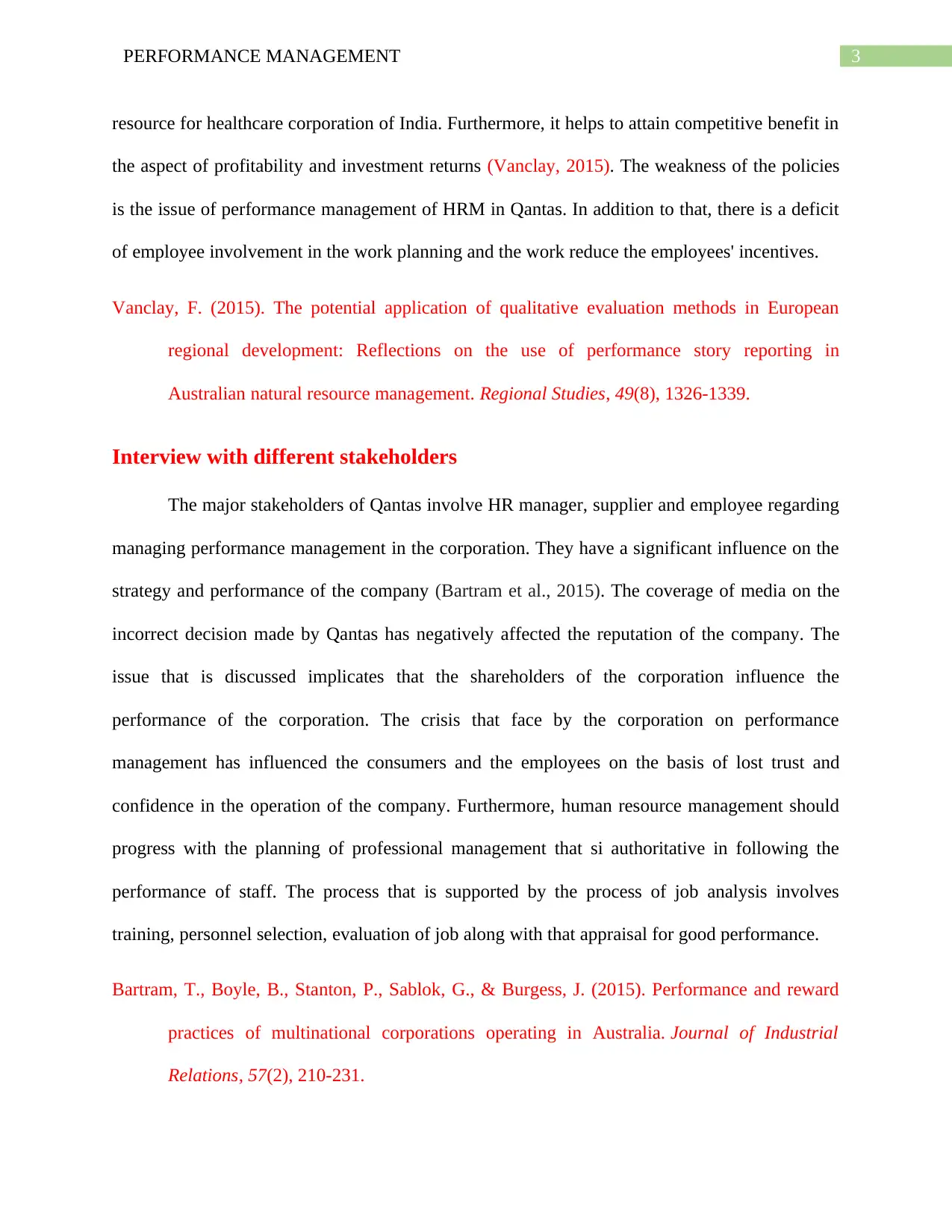
3PERFORMANCE MANAGEMENT
resource for healthcare corporation of India. Furthermore, it helps to attain competitive benefit in
the aspect of profitability and investment returns (Vanclay, 2015). The weakness of the policies
is the issue of performance management of HRM in Qantas. In addition to that, there is a deficit
of employee involvement in the work planning and the work reduce the employees' incentives.
Vanclay, F. (2015). The potential application of qualitative evaluation methods in European
regional development: Reflections on the use of performance story reporting in
Australian natural resource management. Regional Studies, 49(8), 1326-1339.
Interview with different stakeholders
The major stakeholders of Qantas involve HR manager, supplier and employee regarding
managing performance management in the corporation. They have a significant influence on the
strategy and performance of the company (Bartram et al., 2015). The coverage of media on the
incorrect decision made by Qantas has negatively affected the reputation of the company. The
issue that is discussed implicates that the shareholders of the corporation influence the
performance of the corporation. The crisis that face by the corporation on performance
management has influenced the consumers and the employees on the basis of lost trust and
confidence in the operation of the company. Furthermore, human resource management should
progress with the planning of professional management that si authoritative in following the
performance of staff. The process that is supported by the process of job analysis involves
training, personnel selection, evaluation of job along with that appraisal for good performance.
Bartram, T., Boyle, B., Stanton, P., Sablok, G., & Burgess, J. (2015). Performance and reward
practices of multinational corporations operating in Australia. Journal of Industrial
Relations, 57(2), 210-231.
resource for healthcare corporation of India. Furthermore, it helps to attain competitive benefit in
the aspect of profitability and investment returns (Vanclay, 2015). The weakness of the policies
is the issue of performance management of HRM in Qantas. In addition to that, there is a deficit
of employee involvement in the work planning and the work reduce the employees' incentives.
Vanclay, F. (2015). The potential application of qualitative evaluation methods in European
regional development: Reflections on the use of performance story reporting in
Australian natural resource management. Regional Studies, 49(8), 1326-1339.
Interview with different stakeholders
The major stakeholders of Qantas involve HR manager, supplier and employee regarding
managing performance management in the corporation. They have a significant influence on the
strategy and performance of the company (Bartram et al., 2015). The coverage of media on the
incorrect decision made by Qantas has negatively affected the reputation of the company. The
issue that is discussed implicates that the shareholders of the corporation influence the
performance of the corporation. The crisis that face by the corporation on performance
management has influenced the consumers and the employees on the basis of lost trust and
confidence in the operation of the company. Furthermore, human resource management should
progress with the planning of professional management that si authoritative in following the
performance of staff. The process that is supported by the process of job analysis involves
training, personnel selection, evaluation of job along with that appraisal for good performance.
Bartram, T., Boyle, B., Stanton, P., Sablok, G., & Burgess, J. (2015). Performance and reward
practices of multinational corporations operating in Australia. Journal of Industrial
Relations, 57(2), 210-231.
Paraphrase This Document
Need a fresh take? Get an instant paraphrase of this document with our AI Paraphraser
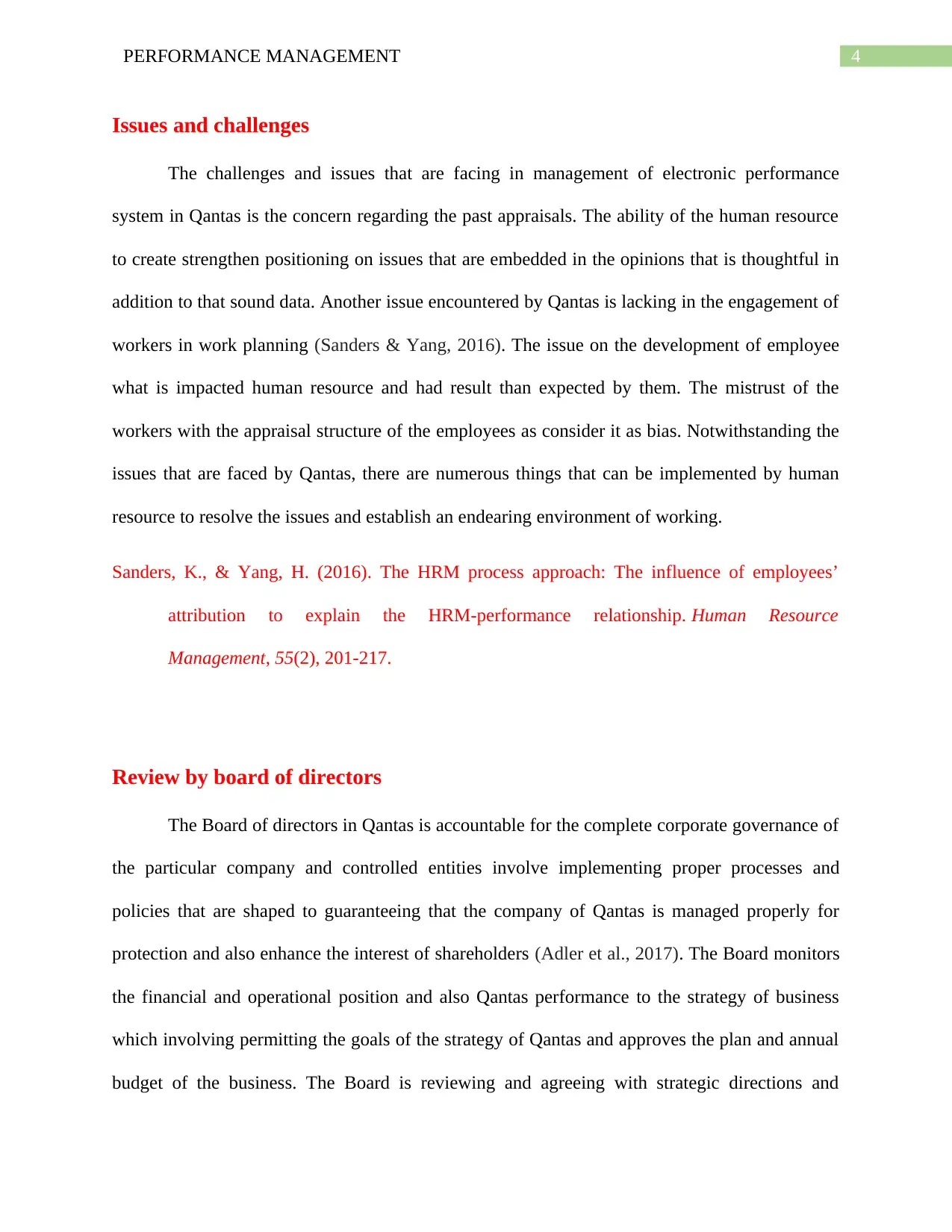
4PERFORMANCE MANAGEMENT
Issues and challenges
The challenges and issues that are facing in management of electronic performance
system in Qantas is the concern regarding the past appraisals. The ability of the human resource
to create strengthen positioning on issues that are embedded in the opinions that is thoughtful in
addition to that sound data. Another issue encountered by Qantas is lacking in the engagement of
workers in work planning (Sanders & Yang, 2016). The issue on the development of employee
what is impacted human resource and had result than expected by them. The mistrust of the
workers with the appraisal structure of the employees as consider it as bias. Notwithstanding the
issues that are faced by Qantas, there are numerous things that can be implemented by human
resource to resolve the issues and establish an endearing environment of working.
Sanders, K., & Yang, H. (2016). The HRM process approach: The influence of employees’
attribution to explain the HRM‐performance relationship. Human Resource
Management, 55(2), 201-217.
Review by board of directors
The Board of directors in Qantas is accountable for the complete corporate governance of
the particular company and controlled entities involve implementing proper processes and
policies that are shaped to guaranteeing that the company of Qantas is managed properly for
protection and also enhance the interest of shareholders (Adler et al., 2017). The Board monitors
the financial and operational position and also Qantas performance to the strategy of business
which involving permitting the goals of the strategy of Qantas and approves the plan and annual
budget of the business. The Board is reviewing and agreeing with strategic directions and
Issues and challenges
The challenges and issues that are facing in management of electronic performance
system in Qantas is the concern regarding the past appraisals. The ability of the human resource
to create strengthen positioning on issues that are embedded in the opinions that is thoughtful in
addition to that sound data. Another issue encountered by Qantas is lacking in the engagement of
workers in work planning (Sanders & Yang, 2016). The issue on the development of employee
what is impacted human resource and had result than expected by them. The mistrust of the
workers with the appraisal structure of the employees as consider it as bias. Notwithstanding the
issues that are faced by Qantas, there are numerous things that can be implemented by human
resource to resolve the issues and establish an endearing environment of working.
Sanders, K., & Yang, H. (2016). The HRM process approach: The influence of employees’
attribution to explain the HRM‐performance relationship. Human Resource
Management, 55(2), 201-217.
Review by board of directors
The Board of directors in Qantas is accountable for the complete corporate governance of
the particular company and controlled entities involve implementing proper processes and
policies that are shaped to guaranteeing that the company of Qantas is managed properly for
protection and also enhance the interest of shareholders (Adler et al., 2017). The Board monitors
the financial and operational position and also Qantas performance to the strategy of business
which involving permitting the goals of the strategy of Qantas and approves the plan and annual
budget of the business. The Board is reviewing and agreeing with strategic directions and
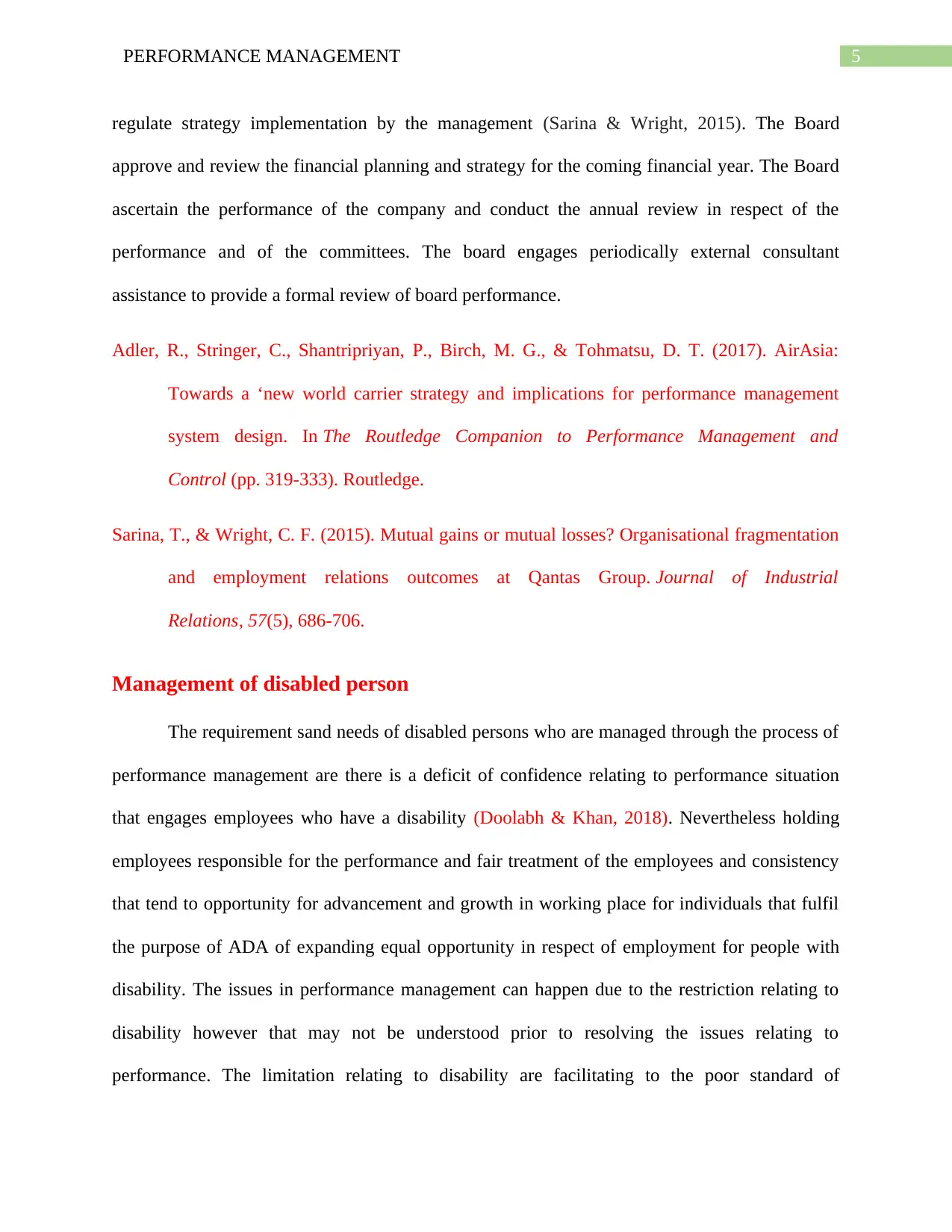
5PERFORMANCE MANAGEMENT
regulate strategy implementation by the management (Sarina & Wright, 2015). The Board
approve and review the financial planning and strategy for the coming financial year. The Board
ascertain the performance of the company and conduct the annual review in respect of the
performance and of the committees. The board engages periodically external consultant
assistance to provide a formal review of board performance.
Adler, R., Stringer, C., Shantripriyan, P., Birch, M. G., & Tohmatsu, D. T. (2017). AirAsia:
Towards a ‘new world carrier strategy and implications for performance management
system design. In The Routledge Companion to Performance Management and
Control (pp. 319-333). Routledge.
Sarina, T., & Wright, C. F. (2015). Mutual gains or mutual losses? Organisational fragmentation
and employment relations outcomes at Qantas Group. Journal of Industrial
Relations, 57(5), 686-706.
Management of disabled person
The requirement sand needs of disabled persons who are managed through the process of
performance management are there is a deficit of confidence relating to performance situation
that engages employees who have a disability (Doolabh & Khan, 2018). Nevertheless holding
employees responsible for the performance and fair treatment of the employees and consistency
that tend to opportunity for advancement and growth in working place for individuals that fulfil
the purpose of ADA of expanding equal opportunity in respect of employment for people with
disability. The issues in performance management can happen due to the restriction relating to
disability however that may not be understood prior to resolving the issues relating to
performance. The limitation relating to disability are facilitating to the poor standard of
regulate strategy implementation by the management (Sarina & Wright, 2015). The Board
approve and review the financial planning and strategy for the coming financial year. The Board
ascertain the performance of the company and conduct the annual review in respect of the
performance and of the committees. The board engages periodically external consultant
assistance to provide a formal review of board performance.
Adler, R., Stringer, C., Shantripriyan, P., Birch, M. G., & Tohmatsu, D. T. (2017). AirAsia:
Towards a ‘new world carrier strategy and implications for performance management
system design. In The Routledge Companion to Performance Management and
Control (pp. 319-333). Routledge.
Sarina, T., & Wright, C. F. (2015). Mutual gains or mutual losses? Organisational fragmentation
and employment relations outcomes at Qantas Group. Journal of Industrial
Relations, 57(5), 686-706.
Management of disabled person
The requirement sand needs of disabled persons who are managed through the process of
performance management are there is a deficit of confidence relating to performance situation
that engages employees who have a disability (Doolabh & Khan, 2018). Nevertheless holding
employees responsible for the performance and fair treatment of the employees and consistency
that tend to opportunity for advancement and growth in working place for individuals that fulfil
the purpose of ADA of expanding equal opportunity in respect of employment for people with
disability. The issues in performance management can happen due to the restriction relating to
disability however that may not be understood prior to resolving the issues relating to
performance. The limitation relating to disability are facilitating to the poor standard of
⊘ This is a preview!⊘
Do you want full access?
Subscribe today to unlock all pages.

Trusted by 1+ million students worldwide
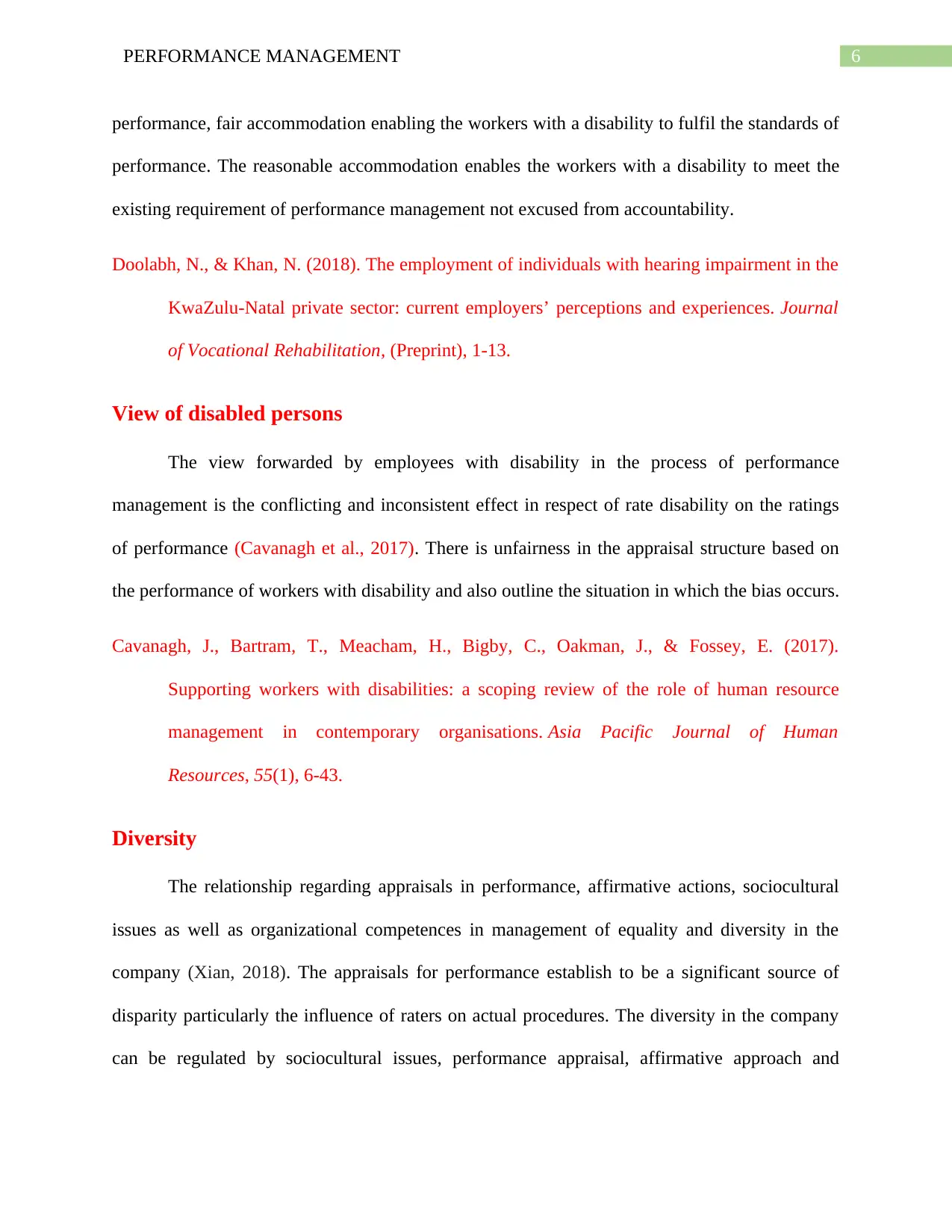
6PERFORMANCE MANAGEMENT
performance, fair accommodation enabling the workers with a disability to fulfil the standards of
performance. The reasonable accommodation enables the workers with a disability to meet the
existing requirement of performance management not excused from accountability.
Doolabh, N., & Khan, N. (2018). The employment of individuals with hearing impairment in the
KwaZulu-Natal private sector: current employers’ perceptions and experiences. Journal
of Vocational Rehabilitation, (Preprint), 1-13.
View of disabled persons
The view forwarded by employees with disability in the process of performance
management is the conflicting and inconsistent effect in respect of rate disability on the ratings
of performance (Cavanagh et al., 2017). There is unfairness in the appraisal structure based on
the performance of workers with disability and also outline the situation in which the bias occurs.
Cavanagh, J., Bartram, T., Meacham, H., Bigby, C., Oakman, J., & Fossey, E. (2017).
Supporting workers with disabilities: a scoping review of the role of human resource
management in contemporary organisations. Asia Pacific Journal of Human
Resources, 55(1), 6-43.
Diversity
The relationship regarding appraisals in performance, affirmative actions, sociocultural
issues as well as organizational competences in management of equality and diversity in the
company (Xian, 2018). The appraisals for performance establish to be a significant source of
disparity particularly the influence of raters on actual procedures. The diversity in the company
can be regulated by sociocultural issues, performance appraisal, affirmative approach and
performance, fair accommodation enabling the workers with a disability to fulfil the standards of
performance. The reasonable accommodation enables the workers with a disability to meet the
existing requirement of performance management not excused from accountability.
Doolabh, N., & Khan, N. (2018). The employment of individuals with hearing impairment in the
KwaZulu-Natal private sector: current employers’ perceptions and experiences. Journal
of Vocational Rehabilitation, (Preprint), 1-13.
View of disabled persons
The view forwarded by employees with disability in the process of performance
management is the conflicting and inconsistent effect in respect of rate disability on the ratings
of performance (Cavanagh et al., 2017). There is unfairness in the appraisal structure based on
the performance of workers with disability and also outline the situation in which the bias occurs.
Cavanagh, J., Bartram, T., Meacham, H., Bigby, C., Oakman, J., & Fossey, E. (2017).
Supporting workers with disabilities: a scoping review of the role of human resource
management in contemporary organisations. Asia Pacific Journal of Human
Resources, 55(1), 6-43.
Diversity
The relationship regarding appraisals in performance, affirmative actions, sociocultural
issues as well as organizational competences in management of equality and diversity in the
company (Xian, 2018). The appraisals for performance establish to be a significant source of
disparity particularly the influence of raters on actual procedures. The diversity in the company
can be regulated by sociocultural issues, performance appraisal, affirmative approach and
Paraphrase This Document
Need a fresh take? Get an instant paraphrase of this document with our AI Paraphraser
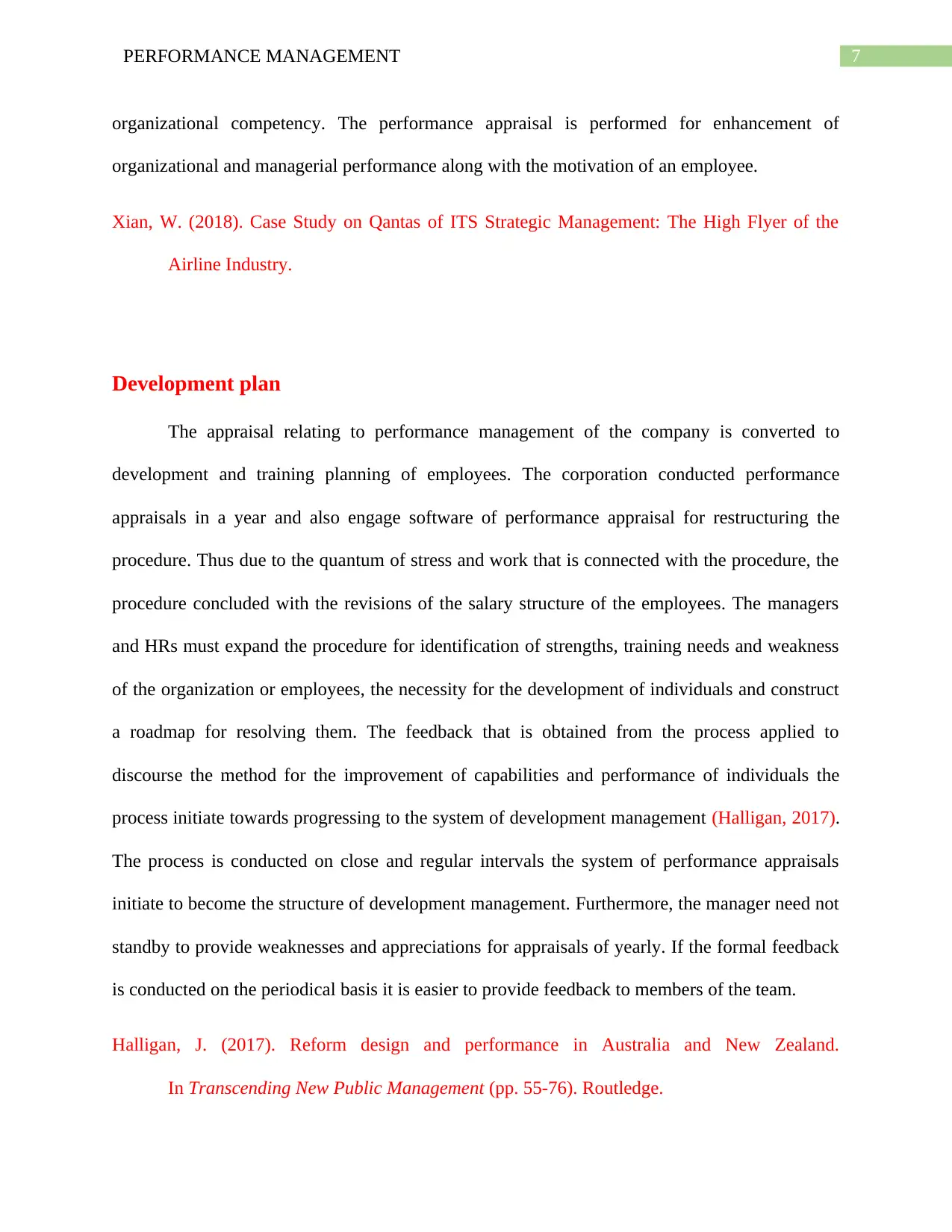
7PERFORMANCE MANAGEMENT
organizational competency. The performance appraisal is performed for enhancement of
organizational and managerial performance along with the motivation of an employee.
Xian, W. (2018). Case Study on Qantas of ITS Strategic Management: The High Flyer of the
Airline Industry.
Development plan
The appraisal relating to performance management of the company is converted to
development and training planning of employees. The corporation conducted performance
appraisals in a year and also engage software of performance appraisal for restructuring the
procedure. Thus due to the quantum of stress and work that is connected with the procedure, the
procedure concluded with the revisions of the salary structure of the employees. The managers
and HRs must expand the procedure for identification of strengths, training needs and weakness
of the organization or employees, the necessity for the development of individuals and construct
a roadmap for resolving them. The feedback that is obtained from the process applied to
discourse the method for the improvement of capabilities and performance of individuals the
process initiate towards progressing to the system of development management (Halligan, 2017).
The process is conducted on close and regular intervals the system of performance appraisals
initiate to become the structure of development management. Furthermore, the manager need not
standby to provide weaknesses and appreciations for appraisals of yearly. If the formal feedback
is conducted on the periodical basis it is easier to provide feedback to members of the team.
Halligan, J. (2017). Reform design and performance in Australia and New Zealand.
In Transcending New Public Management (pp. 55-76). Routledge.
organizational competency. The performance appraisal is performed for enhancement of
organizational and managerial performance along with the motivation of an employee.
Xian, W. (2018). Case Study on Qantas of ITS Strategic Management: The High Flyer of the
Airline Industry.
Development plan
The appraisal relating to performance management of the company is converted to
development and training planning of employees. The corporation conducted performance
appraisals in a year and also engage software of performance appraisal for restructuring the
procedure. Thus due to the quantum of stress and work that is connected with the procedure, the
procedure concluded with the revisions of the salary structure of the employees. The managers
and HRs must expand the procedure for identification of strengths, training needs and weakness
of the organization or employees, the necessity for the development of individuals and construct
a roadmap for resolving them. The feedback that is obtained from the process applied to
discourse the method for the improvement of capabilities and performance of individuals the
process initiate towards progressing to the system of development management (Halligan, 2017).
The process is conducted on close and regular intervals the system of performance appraisals
initiate to become the structure of development management. Furthermore, the manager need not
standby to provide weaknesses and appreciations for appraisals of yearly. If the formal feedback
is conducted on the periodical basis it is easier to provide feedback to members of the team.
Halligan, J. (2017). Reform design and performance in Australia and New Zealand.
In Transcending New Public Management (pp. 55-76). Routledge.

8PERFORMANCE MANAGEMENT
⊘ This is a preview!⊘
Do you want full access?
Subscribe today to unlock all pages.

Trusted by 1+ million students worldwide
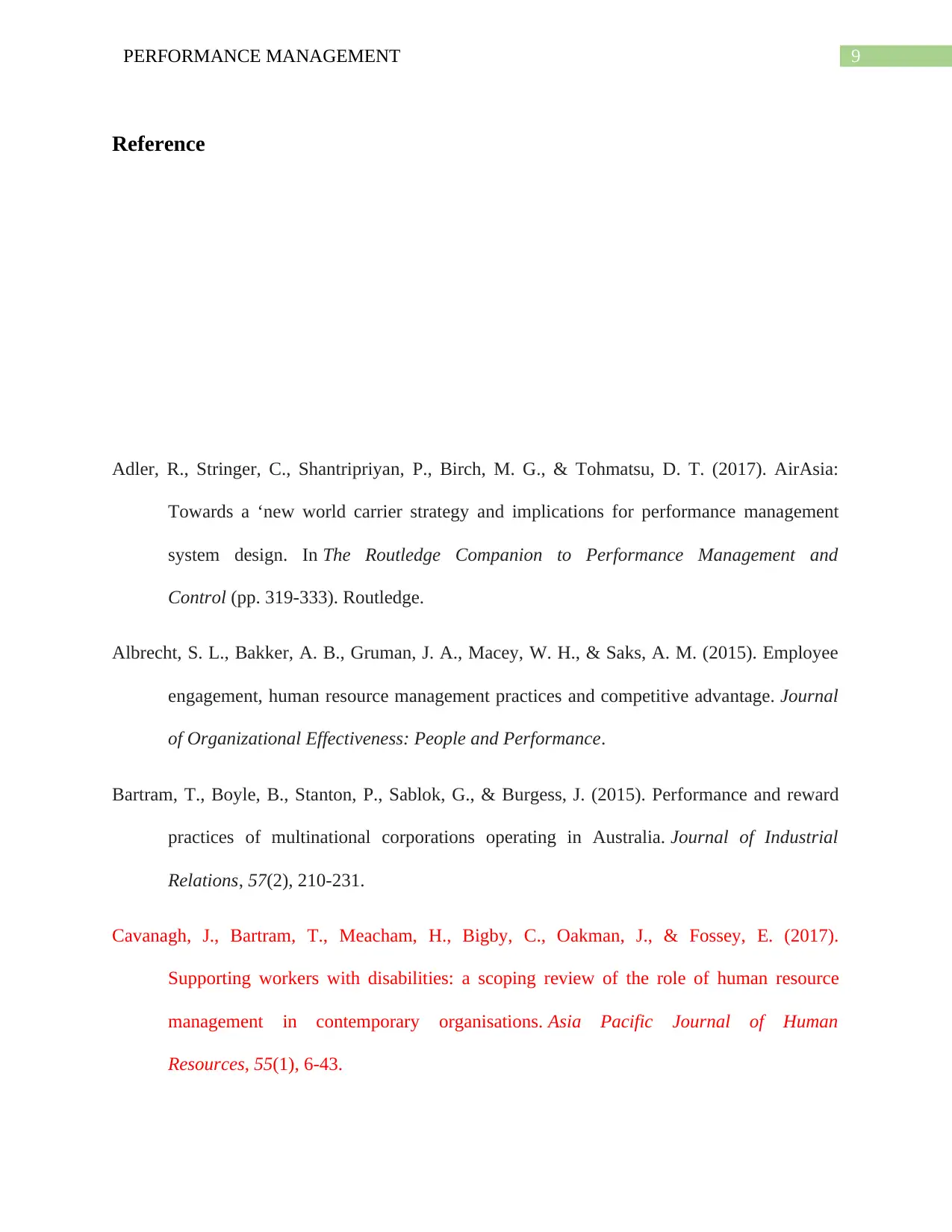
9PERFORMANCE MANAGEMENT
Reference
Adler, R., Stringer, C., Shantripriyan, P., Birch, M. G., & Tohmatsu, D. T. (2017). AirAsia:
Towards a ‘new world carrier strategy and implications for performance management
system design. In The Routledge Companion to Performance Management and
Control (pp. 319-333). Routledge.
Albrecht, S. L., Bakker, A. B., Gruman, J. A., Macey, W. H., & Saks, A. M. (2015). Employee
engagement, human resource management practices and competitive advantage. Journal
of Organizational Effectiveness: People and Performance.
Bartram, T., Boyle, B., Stanton, P., Sablok, G., & Burgess, J. (2015). Performance and reward
practices of multinational corporations operating in Australia. Journal of Industrial
Relations, 57(2), 210-231.
Cavanagh, J., Bartram, T., Meacham, H., Bigby, C., Oakman, J., & Fossey, E. (2017).
Supporting workers with disabilities: a scoping review of the role of human resource
management in contemporary organisations. Asia Pacific Journal of Human
Resources, 55(1), 6-43.
Reference
Adler, R., Stringer, C., Shantripriyan, P., Birch, M. G., & Tohmatsu, D. T. (2017). AirAsia:
Towards a ‘new world carrier strategy and implications for performance management
system design. In The Routledge Companion to Performance Management and
Control (pp. 319-333). Routledge.
Albrecht, S. L., Bakker, A. B., Gruman, J. A., Macey, W. H., & Saks, A. M. (2015). Employee
engagement, human resource management practices and competitive advantage. Journal
of Organizational Effectiveness: People and Performance.
Bartram, T., Boyle, B., Stanton, P., Sablok, G., & Burgess, J. (2015). Performance and reward
practices of multinational corporations operating in Australia. Journal of Industrial
Relations, 57(2), 210-231.
Cavanagh, J., Bartram, T., Meacham, H., Bigby, C., Oakman, J., & Fossey, E. (2017).
Supporting workers with disabilities: a scoping review of the role of human resource
management in contemporary organisations. Asia Pacific Journal of Human
Resources, 55(1), 6-43.
Paraphrase This Document
Need a fresh take? Get an instant paraphrase of this document with our AI Paraphraser
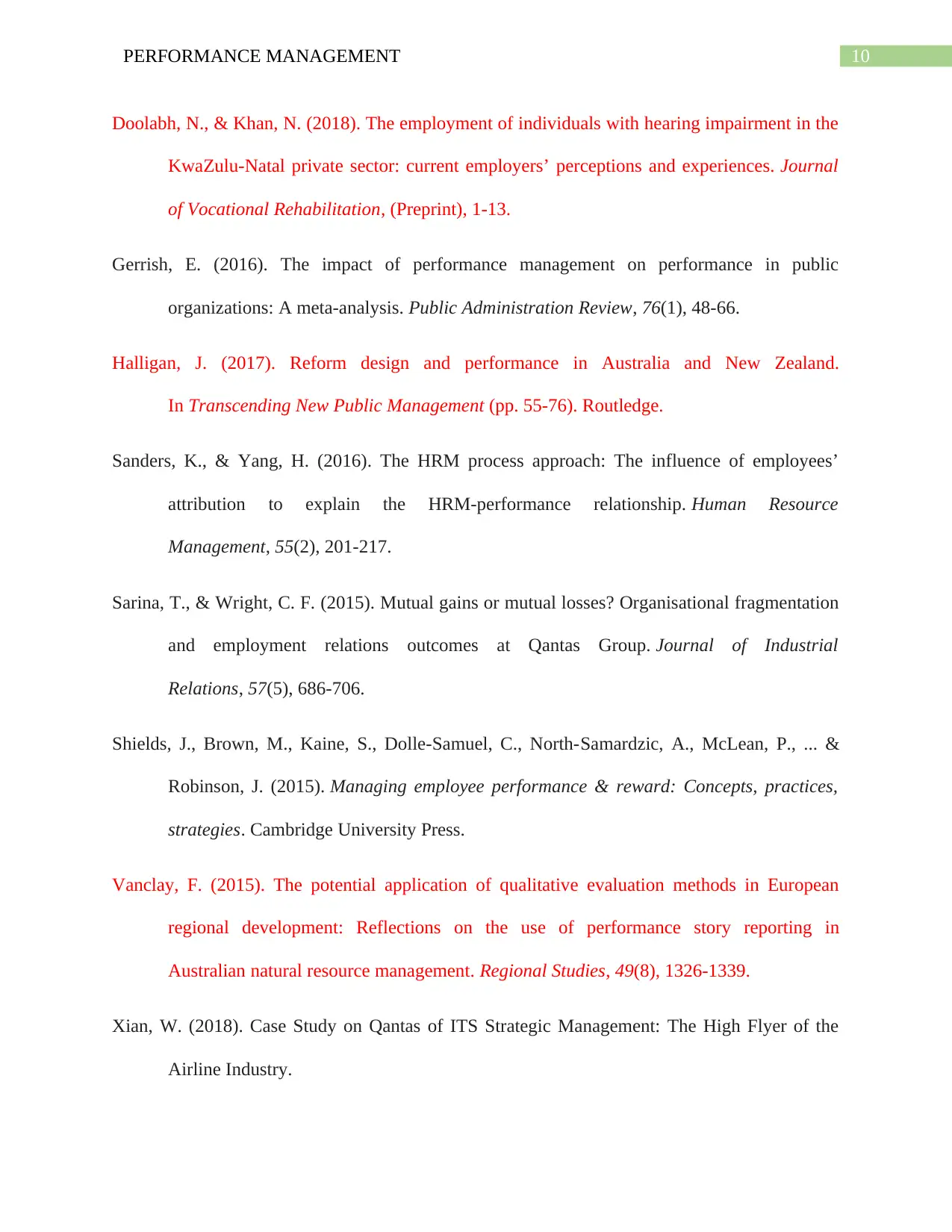
10PERFORMANCE MANAGEMENT
Doolabh, N., & Khan, N. (2018). The employment of individuals with hearing impairment in the
KwaZulu-Natal private sector: current employers’ perceptions and experiences. Journal
of Vocational Rehabilitation, (Preprint), 1-13.
Gerrish, E. (2016). The impact of performance management on performance in public
organizations: A meta‐analysis. Public Administration Review, 76(1), 48-66.
Halligan, J. (2017). Reform design and performance in Australia and New Zealand.
In Transcending New Public Management (pp. 55-76). Routledge.
Sanders, K., & Yang, H. (2016). The HRM process approach: The influence of employees’
attribution to explain the HRM‐performance relationship. Human Resource
Management, 55(2), 201-217.
Sarina, T., & Wright, C. F. (2015). Mutual gains or mutual losses? Organisational fragmentation
and employment relations outcomes at Qantas Group. Journal of Industrial
Relations, 57(5), 686-706.
Shields, J., Brown, M., Kaine, S., Dolle-Samuel, C., North-Samardzic, A., McLean, P., ... &
Robinson, J. (2015). Managing employee performance & reward: Concepts, practices,
strategies. Cambridge University Press.
Vanclay, F. (2015). The potential application of qualitative evaluation methods in European
regional development: Reflections on the use of performance story reporting in
Australian natural resource management. Regional Studies, 49(8), 1326-1339.
Xian, W. (2018). Case Study on Qantas of ITS Strategic Management: The High Flyer of the
Airline Industry.
Doolabh, N., & Khan, N. (2018). The employment of individuals with hearing impairment in the
KwaZulu-Natal private sector: current employers’ perceptions and experiences. Journal
of Vocational Rehabilitation, (Preprint), 1-13.
Gerrish, E. (2016). The impact of performance management on performance in public
organizations: A meta‐analysis. Public Administration Review, 76(1), 48-66.
Halligan, J. (2017). Reform design and performance in Australia and New Zealand.
In Transcending New Public Management (pp. 55-76). Routledge.
Sanders, K., & Yang, H. (2016). The HRM process approach: The influence of employees’
attribution to explain the HRM‐performance relationship. Human Resource
Management, 55(2), 201-217.
Sarina, T., & Wright, C. F. (2015). Mutual gains or mutual losses? Organisational fragmentation
and employment relations outcomes at Qantas Group. Journal of Industrial
Relations, 57(5), 686-706.
Shields, J., Brown, M., Kaine, S., Dolle-Samuel, C., North-Samardzic, A., McLean, P., ... &
Robinson, J. (2015). Managing employee performance & reward: Concepts, practices,
strategies. Cambridge University Press.
Vanclay, F. (2015). The potential application of qualitative evaluation methods in European
regional development: Reflections on the use of performance story reporting in
Australian natural resource management. Regional Studies, 49(8), 1326-1339.
Xian, W. (2018). Case Study on Qantas of ITS Strategic Management: The High Flyer of the
Airline Industry.
1 out of 11
Related Documents
Your All-in-One AI-Powered Toolkit for Academic Success.
+13062052269
info@desklib.com
Available 24*7 on WhatsApp / Email
![[object Object]](/_next/static/media/star-bottom.7253800d.svg)
Unlock your academic potential
Copyright © 2020–2025 A2Z Services. All Rights Reserved. Developed and managed by ZUCOL.





